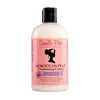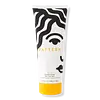What's inside
What's inside
 Key Ingredients
Key Ingredients

No key ingredients
 Benefits
Benefits

 Concerns
Concerns

 Ingredients Side-by-side
Ingredients Side-by-side

Water
Skin ConditioningOpuntia Ficus-Indica Seed Oil
EmollientPrunus Armeniaca Kernel Oil
MaskingUrtica Dioica Extract
AstringentCocos Nucifera Oil
MaskingAloe Barbadensis Leaf Juice
Skin ConditioningSimmondsia Chinensis Seed Oil
EmollientGlycerin
HumectantCetearyl Alcohol
EmollientRosa Canina Fruit Oil
EmollientEquisetum Arvense Extract
AstringentBehentrimonium Methosulfate
Olus Oil
EmollientAlmondeth-20
EmulsifyingTheobroma Cacao Seed Butter
EmollientPhenoxyethanol
PreservativeCitric Acid
BufferingWater, Opuntia Ficus-Indica Seed Oil, Prunus Armeniaca Kernel Oil, Urtica Dioica Extract, Cocos Nucifera Oil, Aloe Barbadensis Leaf Juice, Simmondsia Chinensis Seed Oil, Glycerin, Cetearyl Alcohol, Rosa Canina Fruit Oil, Equisetum Arvense Extract, Behentrimonium Methosulfate, Olus Oil, Almondeth-20, Theobroma Cacao Seed Butter, Phenoxyethanol, Citric Acid
Water
Skin ConditioningCetearyl Alcohol
EmollientStearic Acid
CleansingPersea Gratissima Oil
Skin ConditioningButyrospermum Parkii Butter
Skin ConditioningCetyl Alcohol
EmollientPEG-8 Beeswax
EmulsifyingGlycerin
HumectantEthylhexyl Palmitate
EmollientBehentrimonium Methosulfate
Jojoba Esters
EmollientCarthamus Tinctorius Seed Oil
MaskingHelianthus Annuus Seed Wax
Skin ConditioningGlycine Soja Oil
EmollientAcacia Decurrens Flower Wax
EmollientPolyquaternium-10
Polyquaternium-37
Propylene Glycol Dicaprylate/Dicaprate
EmollientEthylhexylglycerin
Skin ConditioningParfum
MaskingTocopherol
AntioxidantPolyglycerin-3
HumectantPPG-1 Trideceth-6
Skin ConditioningPhenoxyethanol
PreservativeSodium Chloride
MaskingSodium Acetate
BufferingIsopropyl Alcohol
SolventBenzyl Benzoate
AntimicrobialWater, Cetearyl Alcohol, Stearic Acid, Persea Gratissima Oil, Butyrospermum Parkii Butter, Cetyl Alcohol, PEG-8 Beeswax, Glycerin, Ethylhexyl Palmitate, Behentrimonium Methosulfate, Jojoba Esters, Carthamus Tinctorius Seed Oil, Helianthus Annuus Seed Wax, Glycine Soja Oil, Acacia Decurrens Flower Wax, Polyquaternium-10, Polyquaternium-37, Propylene Glycol Dicaprylate/Dicaprate, Ethylhexylglycerin, Parfum, Tocopherol, Polyglycerin-3, PPG-1 Trideceth-6, Phenoxyethanol, Sodium Chloride, Sodium Acetate, Isopropyl Alcohol, Benzyl Benzoate
Ingredients Explained
These ingredients are found in both products.
Ingredients higher up in an ingredient list are typically present in a larger amount.
Behentrimonium Methosulfate is an ammonium salt. It is mainly used to prevent static in haircare products as a surfactant.
Surfactants have differing ends: one side is hydrophilic while the other end is hydrophobic.
Surfactants also help your cleansers remove pollutants more easily from the skin.
Learn more about Behentrimonium MethosulfateCetearyl alcohol is a mixture of two fatty alcohols: cetyl alcohol and stearyl alcohol. It is mainly used as an emulsifier. Emulsifiers help prevent the separation of oils and products. Due to its composition, it can also be used to thicken a product or help create foam.
Cetearyl alcohol is an emollient. Emollients help soothe and hydrate the skin by trapping moisture.
Studies show Cetearyl alcohol is non-toxic and non-irritating. The FDA allows products labeled "alcohol-free" to have fatty alcohols.
This ingredient is usually derived from plant oils such as palm, vegetable, or coconut oils. There is debate on whether this ingredient will cause acne.
Due to the fatty acid base, this ingredient may not be Malassezia folliculitis safe.
Learn more about Cetearyl AlcoholGlycerin is already naturally found in your skin. It helps moisturize and protect your skin.
A study from 2016 found glycerin to be more effective as a humectant than AHAs and hyaluronic acid.
As a humectant, it helps the skin stay hydrated by pulling moisture to your skin. The low molecular weight of glycerin allows it to pull moisture into the deeper layers of your skin.
Hydrated skin improves your skin barrier; Your skin barrier helps protect against irritants and bacteria.
Glycerin has also been found to have antimicrobial and antiviral properties. Due to these properties, glycerin is often used in wound and burn treatments.
In cosmetics, glycerin is usually derived from plants such as soybean or palm. However, it can also be sourced from animals, such as tallow or animal fat.
This ingredient is organic, colorless, odorless, and non-toxic.
Glycerin is the name for this ingredient in American English. British English uses Glycerol/Glycerine.
Learn more about GlycerinPhenoxyethanol is a preservative that has germicide, antimicrobial, and aromatic properties. Studies show that phenoxyethanol can prevent microbial growth. By itself, it has a scent that is similar to that of a rose.
It's often used in formulations along with Caprylyl Glycol to preserve the shelf life of products.
Water. It's the most common cosmetic ingredient of all. You'll usually see it at the top of ingredient lists, meaning that it makes up the largest part of the product.
So why is it so popular? Water most often acts as a solvent - this means that it helps dissolve other ingredients into the formulation.
You'll also recognize water as that liquid we all need to stay alive. If you see this, drink a glass of water. Stay hydrated!
Learn more about Water